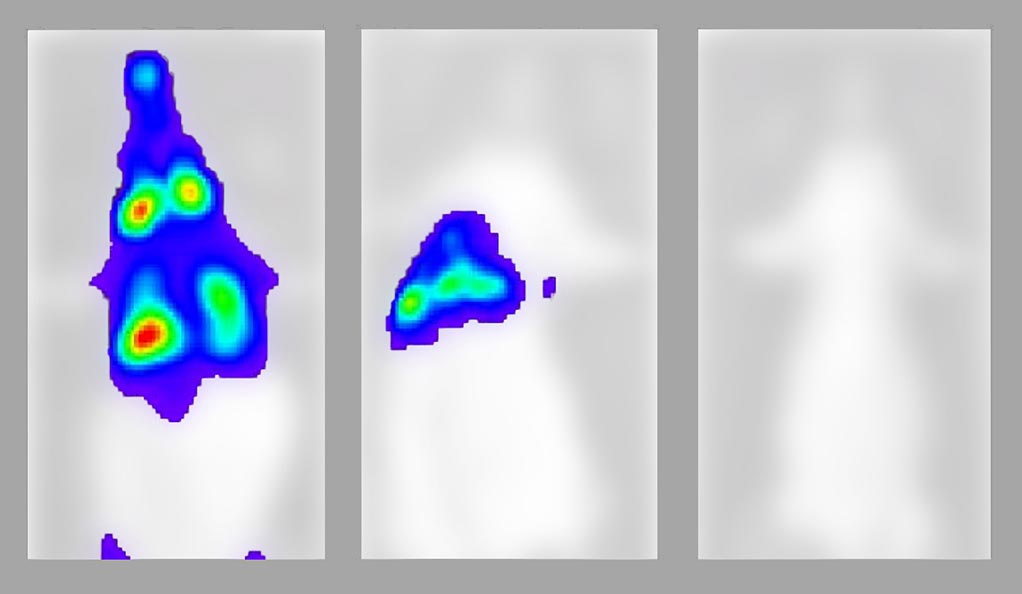Videos Capture Deadly March of COVID-19 Virus
0 View
Share this Video
- Publish Date:
- 21 August, 2021
- Category:
- Covid
- Video License
- Standard License
- Imported From:
- Youtube
Tags

The study, published online in pre-proof form on Aug. 18 in the journal Immunity, was led by Priti Kumar, Pradeep Uchil and Walther Mothes, all of the Yale School of Medicine, as well as Andrés Finzi of the Université de Montréal. Credit: Yale University
Video footage captures the relentless spread of the COVID-19 virus in live animals for the first time, tracking the infection as it moved from mice’s noses to lungs and other organs over the course of six days, in a new research led by researchers from Yale and Université de Montréal.
While the images capture the sometimes deadly march of SARS-CoV-2, the virus that causes COVID-19, they also show how introducing antibodies collected from people who have recovered from the virus can prevent or treat infection. .
However, the study also found that antibodies that are unable to recruit killer immune system cells are less effective at fighting infection.
The study, published online in pre-proof form on Aug. 18 in the journal Immunity, was led by Priti Kumar, Pradeep Uchil and Walther Mothes, all of the Yale School of Medicine, as well as Andrés Finzi of the Université de Montréal.
“For the first time, we were able to visualize the spread of SARS-CoV-2 in a live animal in real time, and most importantly, the places where antibodies must exert effects to halt the progression of the infection,” said Kumar, an associate professor of infectious diseases at the Yale School of Medicine and a co-corresponding author of the article.
For the study, co-lead authors Irfan Ullah, a Yale postdoctoral fellow, and Jérémie Prévost, of Montreal, used bioluminescent tagging and advanced microscopy to track the spread of the virus down to the level of individual cells. In mice, the virus took a route familiar to doctors treating human patients, with high viral loads appearing first in the nasal passages and then traveling rapidly to the lungs and finally to other organs. The mice eventually died when the virus reached the brain.
The researchers then used plasma from people who had recovered from COVID-19 to treat some of the infected mice, which stopped the virus from spreading even if it was not administered until three days after infection. When these antibodies were administered prior to infection with the virus, researchers found, they prevented infection altogether.
“The live reporting of virus spread through imaging can be used to quickly discern whether treatments work within three to five days or not, a crucial time-saving feature to develop countermeasures for current and future pandemics,” said Uchil, a research scientist in the lab of Mothes in Yale’s Department of Microbial Pathogenesis.
However, researchers found that not all antibodies worked equally well. Antibodies have two main roles. Neutralizing antibodies bind to and prevent viruses from entering cells. Then, a second part of the antibody displays so-called “effector” functions, which are necessary to signal the immune system to attack and kill infected cells.
“Antibodies are polyfunctional molecules with different properties,” Finzi said. “In this study, we show that their ability to ‘call for help’ from other cells in the immune system and eliminate infected cells is required to provide optimal protection.”
Kumar added: “We used to think that neutralizing the virus was enough to prevent infection, but antibodies have to be in the right place in the body at the right time and in the right amount. Without the effector function, the neutralizing activity is just not as effective.”
Reference: “Live imaging of SARS-CoV-2 infection in mice reveals that neutralizing antibodies require Fc function for optimal efficacy” by Irfan Ullah, Jérémie Prévost, Mark S. Ladinsky, Helen Stone, Maolin Lu, Sai Priya Anand, Guillaume Beaudoin- Bussières, Kelly Symmes, Mehdi Benlarbi, Shilei Ding, Romain Gasser, Corby Fink, Yaozong Chen, Alexandra Tauzin, Guillaume Goyette, Catherine Bourassa, Halima Medjahed, Matthias Mack, Kunho Chung, Craig B. Wilen, Gregory A. Dekaban, Jimmy D Dikeakos, Emily A. Bruce, Daniel E. Kaufmann, Leonidas Stamatatos, Andrew T. McGuire, Jonathan Richard, Marzena Pazgier, Pamela J. Bjorkman, Walther Mothes, Andrés Finzi, Priti Kumar and Pradeep D. Uchil, Accepted, Immunity .
DOI: 10.1016/j.immuni.2021.08.015
Other contributors included Craig Wilen of Yale University, Mark Ladinsky and Pamela Bjorkman of California Institute of Technology, Leonidas Stamatatos and Andrew McGuire of Fred Hutchinson Cancer Research Center, and Marzena Pazgier of Uniformed Services University of the Health Sciences.










